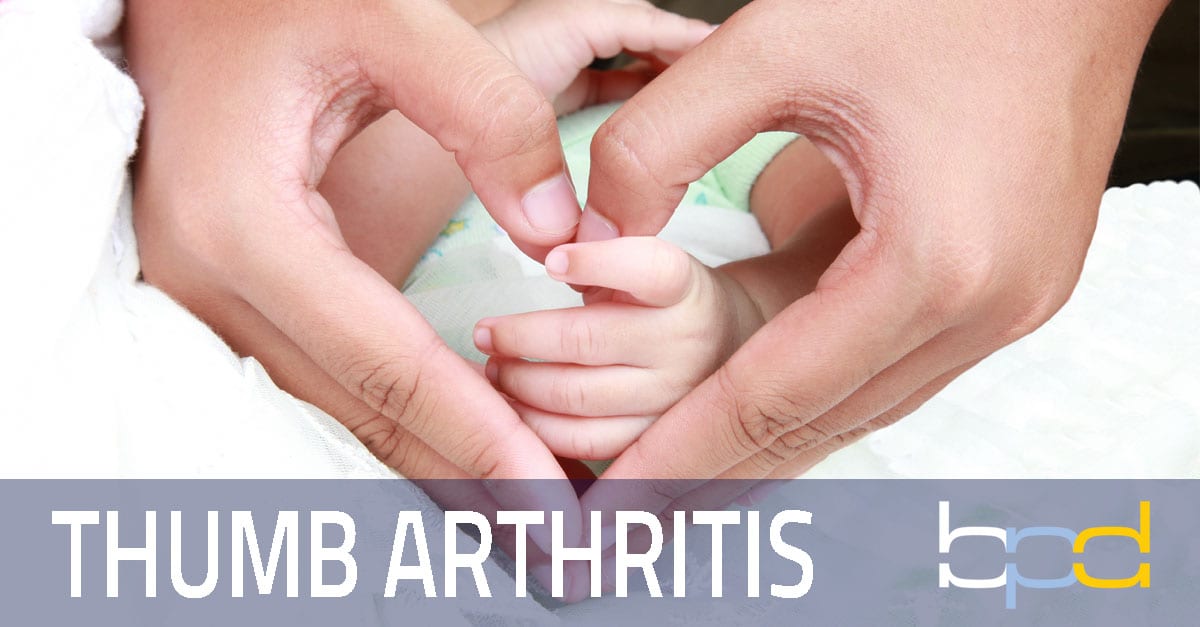
Basal Joint Arthritis Symptoms and Treatment
Mother’s Day is just around the corner, and if your mom has chronic hand pain or has struggled to open a jar of food, she may have the early warning signs of a serious condition. There are several hand conditions that primarily affect women. One such condition that Dr. Donnelly sees quite often is basal joint arthritis. In today’s post, we’ll discuss basal joint arthritis and treatment options.
What is Basal Joint Arthritis?
The basal joint is found at the base of the thumb where it joins the wrist. This complex joint gives the thumb a wide range of motions - up, down, across the palm, as well as the ability to pinch.
The pain from basal joint arthritis is typically located at the base of the thumb, but may also extend into the wrist or the palm. Basal joint arthritis, also called thumb arthritis or caropometacarpal (CMC) joint arthritis, occurs when the cartilage that covers the thumb joint wears down over time. Because women’s ligaments tend to be more lax than that of men, this type of arthritis more often affects our Moms.
What are the Symptoms of Basal Joint Arthritis?
If your Mom struggles with previously simple tasks, such as turning door knobs, opening jars, and pinching her keys, she may be showing early signs of basal joint arthritis. She may also experience aching or burning in the thumb and wrist area even when not attempting to grasp something. In addition, swelling or an unusual bump may appear at the base of the thumb.
Any of the following symptoms may be indications of basal joint arthritis. Ask Mom if she is experiencing any of these symptoms throughout her day:
- hand pain
- joint stiffness
- weakness in the hand or fingers
- decreased range of motion
- swollen thumb (especially at the base)
- bump at the thumb joint
- unusual (bent-back) appearance of the thumb
Treatments for basal joint arthritis range from simple observation to surgical reconstruction of the arthritic joint.
Non-Surgical Treatment Options
Now for some good news. There are a variety of non-surgical treatment options for basal joint arthritis. If diagnosed and treated early, patients can find long-term relief.
The most common non-surgical treatments include:
Activity Modification
Change or avoid activities or motions that produce pain.
Nonsteroidal Anti-inflammatory Drugs (NSAIDs)
Over-the-counter and prescription medications like aspirin and ibuprofen decrease inflammation and relieve pain.
Ice
Icing the joint and surrounding area will help reduce swelling and ease pain.
Splinting
A splint supports the base of thumb and takes pressure off the basal joint.
Steroid Injections
Fast acting anti-inflammatory medication is injected into the arthritic joint to help relieve pain.
Basal Joint Arthritis Surgery
If conservative treatment options do not relieve the pain, surgery might be recommended. Treatment options for basal joint arthritis include:
Join Fusion
The bones of the basal joint are permanently fused.
Osteotomy
An osteotomy surgically repositions the bones in the thumb joint.
Trapeziectomy
A trapeziectomy removes the arthritic trapezium bone.
Joint Replacement
Basal joint replacement is when the basal joint is removed and replaced with a tendon graft.
The exact procedure is determined based on the severity of the disease as well as the patient's occupation and activity level.
Get a Diagnosis for Thumb Pain
It's not unusual for Moms to put everyone else first. This Mother’s day, let’s put them first. If you or your mom has been suffering with hand pain, basal joint arthritis may be the culprit.
Please don’t ignore the warning signs of this painful condition. With an early diagnosis, Mom has a wide range of treatment options available.
Call Dr. Donnelly's office today to schedule an evaluation and learn more about treatment options for basal joint arthritis.
This site is not intended to and does not provide medical advice, professional diagnosis, opinion, treatment or services to you or to any other individual. Through this website and links to other websites, Brandon P. Donnelly, MD provides general information for educational purposes only. The content provided in this website and links, is not a substitute for medical care or treatment. You should not use this information in place of a consultation or the advice of your healthcare provider. Brandon P. Donnelly, MD is not liable or responsible for any advice, course of treatment, diagnosis or any other information, services or product you obtain through this site.

